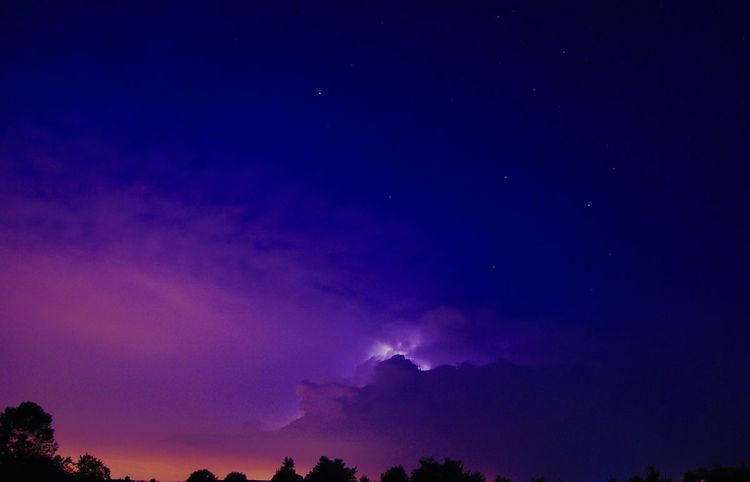 | ||
Heat lightning, sometimes known as silent lightning, is the name used for the faint flashes of lightning on the horizon or other clouds from distant thunderstorms that do not have accompanying sounds of thunder. This often occurs because of inter-cloud and intra-cloud lightning, where lightning charges travel from cloud-to-cloud or merely areas of differing electric potential within a single cloud, respectively. Because of this nature, heat lightning can often be seen from great distances, and thus can be an early warning sign that thunderstorms are approaching. The term could be considered a misnomer because it has nothing to do with the heat of the lightning itself.
Heat lightning can also occur if cloud-to-ground lightning occurs very far away and the sound dissipates before it reaches the observer. At night, it is possible to see the flashes of lightning from very far distances, up to 100 miles, but the sound does not carry that far. In Florida, heat lightning is often seen over the water at night, the remnants of storms that formed during the day along a sea breeze front coming in from the opposite coast.
Heat lightning also occurs where airborne matter muffles the thunder, such as heavy snow in winter storms (thundersnow) and dust and sand storms. In some instances, heavy falling snow has silenced thunder from cloud to ground lightning strikes as close as one to two miles (1.6 to 3.2 km) from the observer and severe dust storms are even more effective in many cases.
Heat lightning is not to be confused with electrically-induced luminosity actually generated at mesospheric altitudes above thunderstorm systems (and likewise visible at exceedingly great ranges), a phenomenon known as "sprites".
Cloud-to-ground Lightning
The movement of sound in the atmosphere depends on the properties of the air, such as temperature and density. Because temperature and density change with height, the sound of thunder is refracted through the troposphere. This refraction results in spaces through which the thunder does not propagate. The sound of thunder often reflects off the Earth's surface. The rumbling sound is partly due to these reflections. This reflection and refraction leaves voids where thunder cannot be heard.
The Earth's curvature also contributes to distant observers not hearing the thunderclap. Thunder is more likely to be bounced off the Earth's surface before it reaches an observer far from the strike, and only the right refraction and reflection of the sound off of the atmosphere will give it range it needs to be heard far away. The reflection and refraction in the troposphere determines who hears the strike and who doesn't. Usually the troposphere will reflect the light, and leave out the sound - in these cases some fraction of the light emanating from distant thunderstorms (whose distant clouds may be so low to the horizon as to be essentially invisible) is scattered by the upper atmosphere and thus visible to remote observers.
Under optimum conditions, the most intense thunderstorms can be seen at up to 100 miles (161 km) over flat terrain or water when the clouds are illuminated by large lightning discharges. However, an upper limit of 30–50 miles (48–80 km) is more common due to topography, trees on the horizon, low to mid level clouds, and the fact that local visibilities are generally no more than 25 miles (40 km). Variability of anvil height (an anvil is the large, plume-like top of a thunderhead) also contributes—45,000 feet (13,715 m) is very common in the mid latitudes for warm season thunderstorms, but the anvil height can range from 35,000 feet (10,665 m) to a current record of 78,000 feet (23,770 m).
